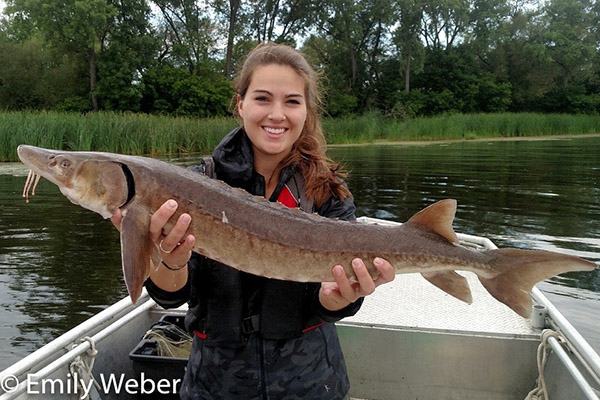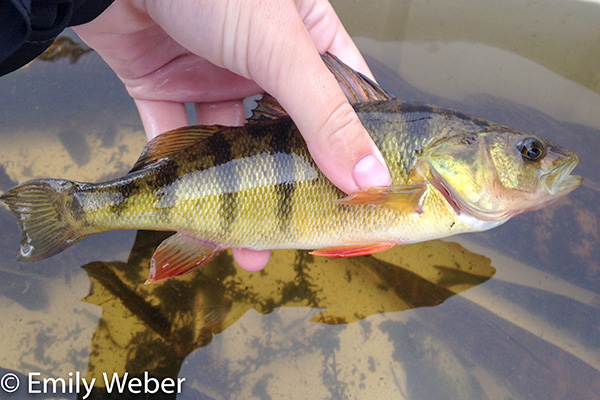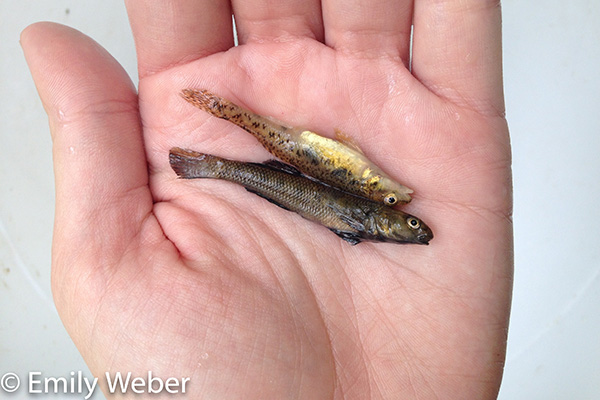Fish

Fox River Fish
Despite more than a century of agricultural, municipal and industrial pollution, the seven miles of the lower Fox River from the De Pere Dam to the waters of Green Bay today support one of the most productive recreational fisheries in Wisconsin and probably in the entire western Great Lakes region. The “Fox River fish” group includes fish species that use the Fox River north of the De Pere dam as residents, seasonal migrants or for development during critical life stages, including but not limited to: sunfishes and basses (Centrarchidae), channel catfish (Ictalurus punctatus), lake whitefish (Coregonus clupeaformis), lake sturgeon (Acipenser fulvescens), walleye (Sander vitreus), etc. Lake sturgeon is a state-listed special concern species and is considered “vulnerable” in the state (S3 rank).
Many fish species, including those in the Fox River fish group, were originally listed in the RAP because of poor quality spawning habitat, impaired reproduction, low overall fish diversity, poor water quality, fish passage barriers and introduction of invasive species such as zebra/quagga mussel and sea lamprey (Qualls et al. 2013, Wisconsin Department of Natural Resources 2016a). Fox River fish are good indicators of ecological condition in the LGBFR AOC because they consume prey that depend on the coastal or nearshore environment, which may contain environmental contaminants such as polychlorinated biphenyls (PCBs) and mercury (Catfish Fact Sheet, Qualls et al. 2013). Predators higher in the food chain that consume Fox River fish species (including people) are vulnerable to bioaccumulation of these organic toxins, which can cause reproductive issues or deformities (Qualls et al. 2013). Today, fish advisories recommending safe fish consumption by species are regularly posted at boat launches and parks along the Fox River.

Shoreline Fish
The “shoreline fish” group consists of 25 species inhabiting shoreline areas and shallow open water. Many of the fish species described in this early account are still represented in the LGBFR AOC, although invasive species and habitat modifications have changed the shoreline fish community irreversibly. Here we describe four native taxa (smallmouth bass, muskellunge, yellow perch and shoreline/wetland Centrachidae) that have historical, ecological and economic importance in this ecosystem. Other species included in our assessment metric represent a broader fish diversity in the shoreline zone, in some cases overlapping with species in the tributary fish category.
Smallmouth bass use the pelagic zone of the lower bay, including Point au Sable and UW-Green Bay campus shoreline, Fox River, and upper Duck Creek (Lower Green Bay and Fox River Area of Concern Biota Database, Wisconsin Department of Natural Resources Fish Mapping Application 2018).
Great Lakes muskellunge is perhaps the most important game fish in the state. They have recently been reported using the Fox River and open water of the lower bay including Dead Horse Bay (LGBFR AOC Biota Database, Wisconsin Department of Natural Resources Fish Mapping Application 2018). Since 2000, WDNR’s Steve Hogler has conducted musky spawning surveys in the Fox River just north of Voyageur Park and near the railroad bridge, where they are known to spawn.
When Great Lakes water quality declined in the early 1900s due to industrial, urban and agricultural pollution, populations of native species like lake whitefish, lake trout and lake sturgeon declined. Yellow perch populations, by contrast, exploded since they are tolerant of poorer water quality, high nutrients and low oxygen. Despite their wide tolerance, yellow perch are sensitive to highly degraded water quality and other ecological disruptions; the large populations of the late twentieth century are no longer present today in the LGBFR AOC. As a part of his UW-Green Bay Cofrin Student Research Grant, student David Lawrence discovered that Wequiock Creek, which enters the bay at Point au Sable, provides important nursery habitat for yellow perch. Areas like Wequiock Creek are especially important for yellow perch, because their most critical life stage is when they are juveniles, a life history stage where they need protected streams and open water habitat (Qualls et al. 2013, S. Hogler, pers. comm.).

Tributary Fish
Fish species in this category include those that utilize small tributaries or streams (up to the 1 km LGBFR AOC boundary) for residency, reproduction or for nursery habitat, including but not limited to: suckers (Catostomidae), minnows (Cyprinidae), northern pike (Esox lucius), yellow perch (Perca flavescens), etc.
Pike travel upstream primarily along the west shore and smaller tributaries along the Fox River, including the East River, Dutchman Creek, and Ashwaubenon Creek (S. Hogler and C. Larscheid, pers. comm.). Unlike other fish species, northern pike can tolerate low oxygen levels in waterways making them less vulnerable to fish kills. The biggest threat to pike is the destruction of spawning habitat, though the WDNR and others have been actively restoring and improving wetlands and migratory corridors (including removing fish passage barriers) along the west shore of the bay (Qualls et al. 2013).
Longnose suckers have recently been reported in the pelagic zone of the lower bay, while white suckers have been reported in Duck Creek, Fox River, East River, Wequiock Creek, Ashwaubenon Creek, Dutchman Creek and the pelagic zone of the lower bay including near Atkinson, Dead Horse Bay, Longtail Point, Point au Sable and the UW-Green Bay campus.
Both bluntnose and fathead minnows have been frequently detected throughout the LGBFR AOC. Brassy minnows have been found in Wequiock Creek, southern redbelly dace has been recorded using the pelagic zone of the lower bay and Duck Creek, and redside dace use the lower bay’s pelagic zone, Duck Creek and Baird Creek.
Tributary fish of Green Bay are important links in the bioaccumulation of environmental contaminants such as polychlorinated biphenyls (PCBs), pesticides and mercury. Top predators such as northern pike and walleye are especially vulnerable to bioaccumulation of these toxins, which can cause reproductive issues or deformities (Qualls et al. 2013). Today, fish advisories based on PCBs are regularly posted at boat launches and parks that provide recommendations on safe fish consumption listed by species (Northern Pike Fact Sheet).

Ask an Expert
As a proud alumna of UW-Green Bay, Erin Giese understands the need to provide hands-on experiences for students. She's committed to training the next generation of scientists who help to improve the LGBFR AOC. If you have questions, she can help!